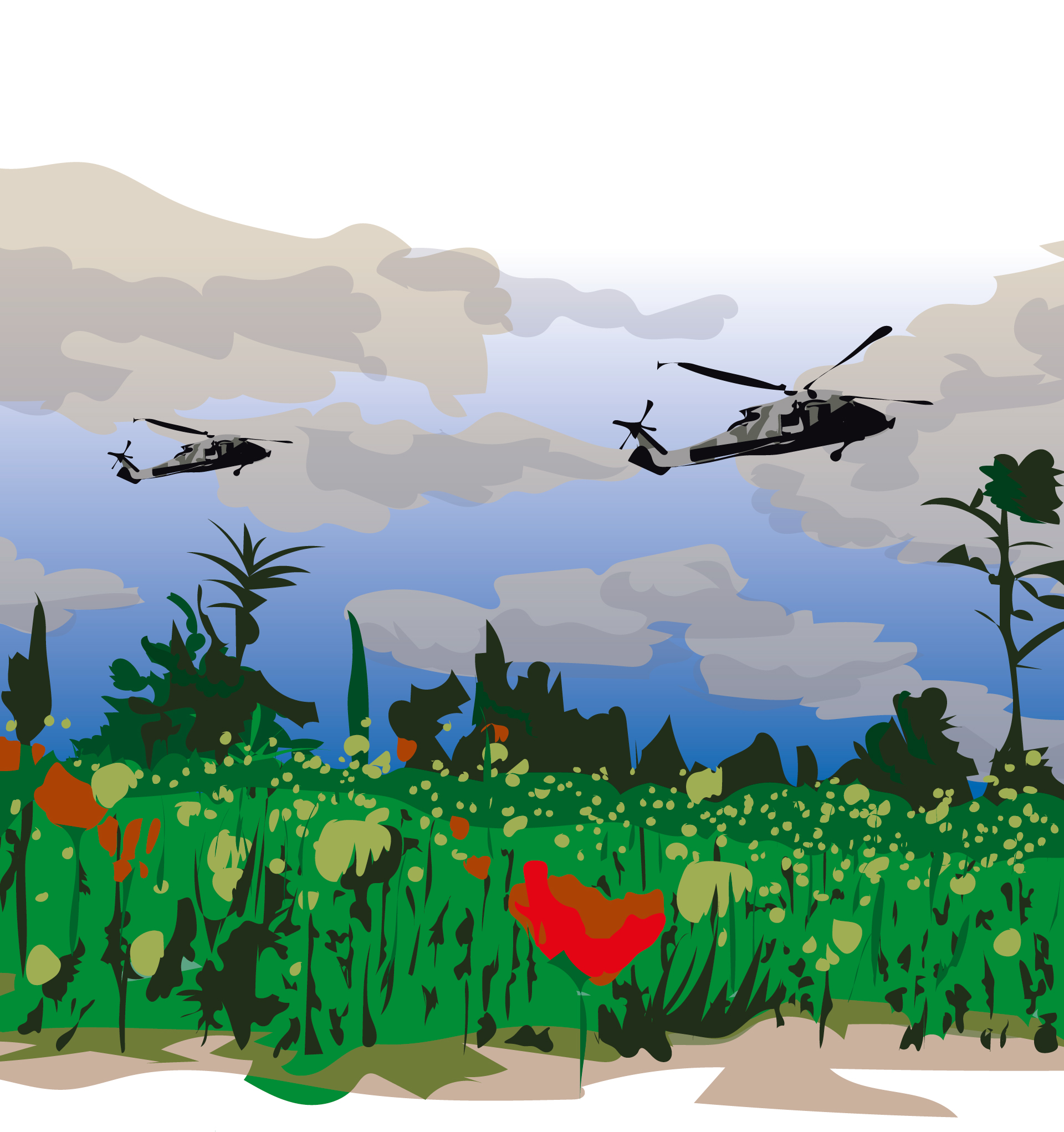This report is part of the Noria Opium Project.
Is Opium Poppy Production Violent?
If we were to conduct a survey based on this question we would, without doubt, receive a majority of affirmative responses. Indeed, the following argument has been accepted for many years: since poppy cultivation is prohibited, and illicit markets operate in the extralegal sphere, high levels of violence should exist because both activities are governed only by the “law of the strongest.”
This is a reasoning often utilized in the Latin American context. Based on the co-existence of high homicide rates and extensive drug-trafficking networks in several countries in the region, the conclusion is that violence is an intrinsic characteristic of illicit markets that, therefore, must be combatted through security approaches. In addition to ignoring historical studies that demonstrate how illicit markets have operated in distinct periods with low levels of violence,1 this argument occults various degrees of complexity that we set out in this text.
The attention that the media, politicians, and scholars have devoted to illicit markets tends to operate with a “selective bias”, since it focuses on contexts marked by high homicide rates.
First, there are dozens of examples worldwide (including some from Latin America) that contradict the mechanical relation between illicit markets and homicidal violence mentioned above, as Andreas and Wallman have demonstrated.2 Second, the two researchers also show that the attention that the media, politicians, and scholars have devoted to illicit markets tends to operate with a “selective bias”, since it focuses on contexts marked by high homicide rates. How else are we to explain that MDMA (ecstasy) trafficking in Holland, Bolivia’s coca and cocaine markets, or international art theft, none of them characterized by high levels of homicides, do not receive the same coverage as drug-trafficking in Mexico and Colombia?
Then, the urge to find a general explanation for violence in Mexico tends to homogenize the dynamics of regulation of illicit activities and markets, by denying local realities and several significant differences between products: natural vs. synthetic drugs, trafficking of stolen cars vs. money laundering, to cite a couple of examples.
Our Opium Project has shown that these macro approaches share a common sin of omission, by failing to recognize the complexity of illicit markets and their links to the formal economy,3 and of imposition, by framing paradigms that have become ‘official’ histories, though bereft of supporting evidence.4
In the case that concerns us here, we will see that there is no systematic relation between homicidal violence and the presence of poppies in territories in Mexico.
Analyzing whether the poppy is violent requires verifying: (i) if cultivating the plant is, per se, a violent activity; (ii) if the trafficking organizations that use coercion are violent; and (iii) if public policies based on militarization and eradication, designed to “win” the war on drugs, contribute to generating violence in the populations dedicated to this economic activity.
The present text focuses on the third issue; that is, the impact of public security forces in poppy-growing territories. We will demonstrate how distinct forms of violence are exercised while questioning the implementation and legitimacy of campaigns organized to eradicate crops that have been declared “illicit”.
There is no systematic relation between homicidal violence and the presence of poppies in territories in Mexico.
Finally, we defend the idea that homicide rates cannot be used as the only standard of violence in Mexico. As the anthropologist Dennis Rodgers5 has analyzed so effectively, statistics on murders have emerged as the only “benchmark” applied to study and measure violence in Latin America. This tends to invisibilize other mechanisms of domination and coercion that are constructed parallel to lethal violence and involve inequalities, the criminalization of poverty, the effects of public security policies, and market forces, among other elements. It also contributes to minimizing the role that public security forces play in the use of violence, lethal or otherwise, in the regions where they operate, or to absolving them of responsibility.
If we continue to consider homicide as the only, or main, manifestation of violence, we will remain unable to understand the broad variation that exists in the lived realities of poppy-producing communities in the context of Mexico’s complex, ever-changing “war on drugs”.6
Homicides in poppy-growing municipalities.
A heterogeneous panorama.
From 1990 to 2019, 99% of the 476,251 hectares (h)7 of poppy fields registered as destroyed by Mexican authorities were concentrated in just six states.
Those fields belong to what the Ministry of National Defense (SEDENA) classifies as areas of “high and medium incidence of illicit crops”:8
-1- Guerrero: 221,878 h
-2- Chihuahua: 82,502 h
-3- Durango: 80,690 h
-4- Sinaloa: 55,399 h
-5- Nayarit: 17,580 h
-6- Oaxaca: 14,423 h
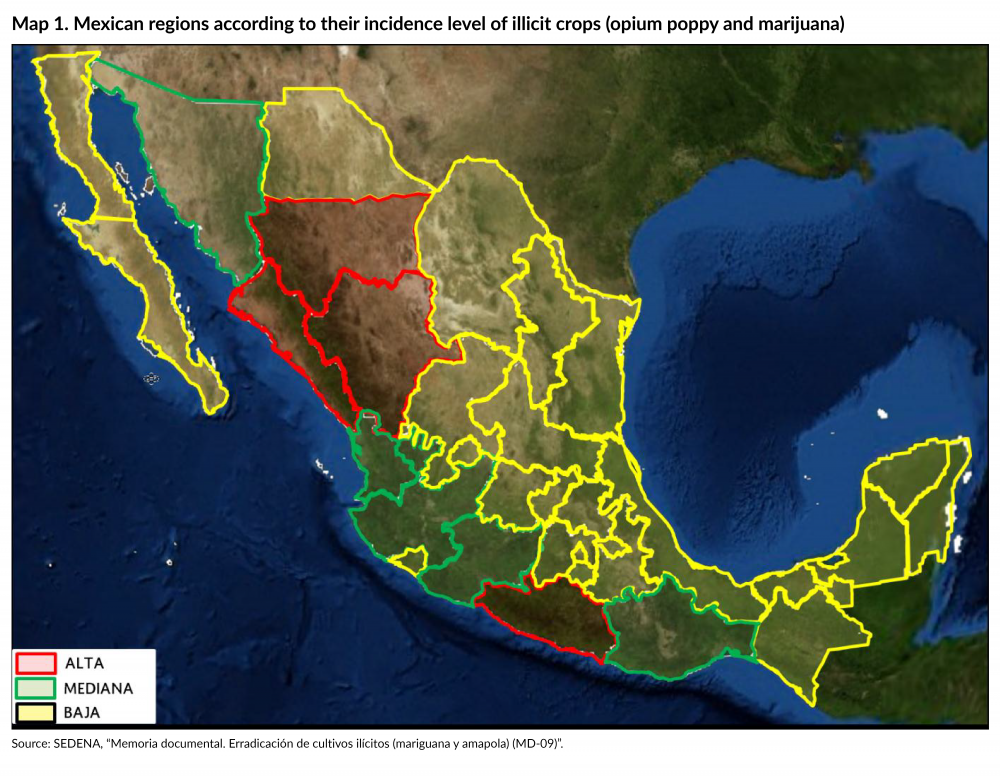
This geographic concentration can be broken down by municipality. The 50 municipalities with the largest areas of poppy cultivation reported as destroyed from 1990 to 2019 are in the six states just mentioned.9 However, the social structures and scenarios of agricultural production in those municipalities are heterogeneous. For example, while in Culiacán (Sinaloa) poppies are cultivated close to a city of over one million inhabitants, inserted in a context of profitable, legal economic activities, in Copanatoyac (Guerrero), they are grown in rural zones with a few hundred inhabitants that are particularly poorly connected to the rest of the state.
Just as broad socioeconomic heterogeneity exists, the structural conditions and conjunctural dynamics of violence that these municipalities have lived over the past three decades are also diverse. Focusing on homicides, our first observation is that the administrative centers (cabecera municipal) of the poppy-growing municipalities with the largest number of cases are highly urbanized and rather densely populated: Culiacán, (Sinaloa), Chihuahua (Chihuahua), and Durango (Durango), which are also the capitals of their respective states.10
Available data do not reveal any clear relation between homicide rates and poppy eradication
Upon examining data on homicides per number of inhabitants to obtain measures of the comparative risk of being murdered in territories of differing population size, four municipalities in the Sierra Tarahumara region of Chihuahua –Guadalupe y Calvo, Guazapares, Morelos, Guachochi– and one in Sinaloa, Badiraguato, stand out with rates of 24-41 homicides per 1,000 inhabitants from 1990 to 2019.11 At the opposite end of the spectrum of lethal violence in poppy-growing municipalities, Acatepec and Malinaltepec (Guerrero) suffered “only” 4 and 5 homicides per 1,000 inhabitants, respectively.12
In this context, it is important to emphasize that the data available do not reveal any clear relation between homicide rates and poppy eradication; thus, we proceeded to look at places with equivalent areas of eradicated poppy fields during the study period. We discovered that Guadalupe y Calvo (Chihuahua) had a homicide rate almost five times greater than Tamazula (Durango) (see Table 1 and Map 2). Similarly, but within the region of the Montaña in Guerrero, a broad difference in homicide rates occurred between Tlacoapa and Copanatoyac, with 8 vs. 19 murders per 1,000 inhabitants, though these two municipalities had similar figures for poppy eradication: 2,199 vs. 2,097 h.13
Limits in the link between eradication and homicides
How, then, are we to explain that poppy eradication does not produce –nor is produced in– contexts of lethal violence that are proportional to the intensity of fumigation and eradication of fields?
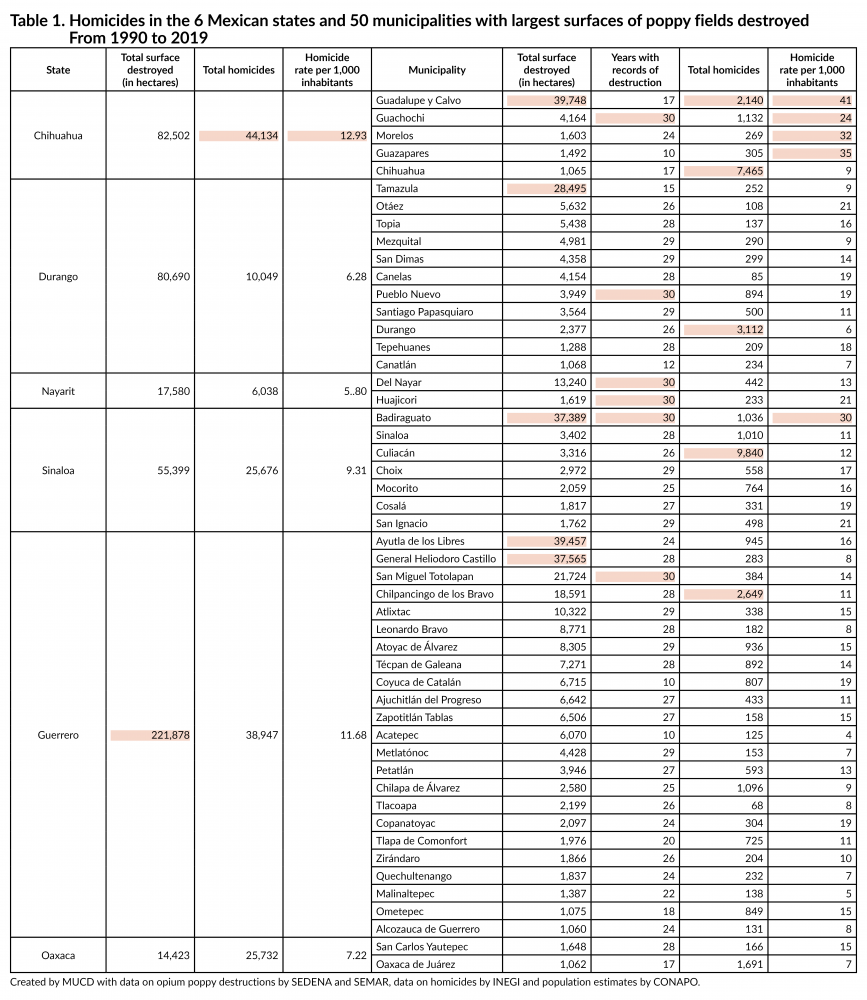
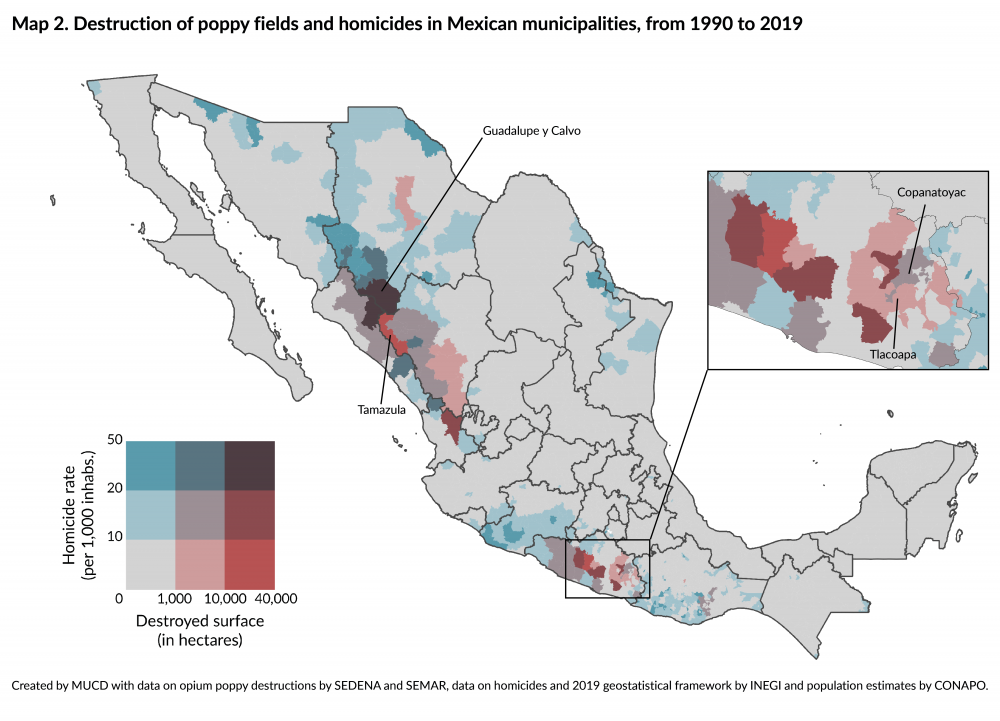
Unfortunately, our quantitative approach to the lethal violence associated with poppy eradication runs into a fundamental obstacle: a lack of precision in the data available. The previous section compared two phenomena recorded in the same territorial unit, the municipality. It was necessary to operate at this level because authorities affirm that they do not record statistical data on the destruction of illicit crops at the intra-municipal level.14 As a result, our comparisons also omit the fact that several of the municipalities cited cover extensive territories with broad rural areas but few communication routes. In those settings, it is not unusual to find that the social phenomena observed in remote ranches or communities develop in ways quite distinct from the dynamics of the cabeceras.
When poppy plantations are found in zones far from the cabecera, and there is little communication between those areas, it is difficult to determine whether the dynamics of violence measured at the municipal level actually reflect phenomena associated with poppy cultivation, or simply reflect events that occur in the municipality, dozens –perhaps hundreds– of kilometers and hours of travel away. For example, the city of Badiraguato in Sinaloa and the town of Saca de Agua, in the far northern reaches of that municipality, are separated by 148 kilometers.
In the case of Guerrero, Coyuca de Catalán illustrates this disconnect. In this municipality in the Sierra some zones of poppy cultivation are almost ten hours by road transport from the cabecera. For this reason, residents interact very little with local government (ayuntamiento); in daily life, and for goods and services, they go to cities in the Costa Grande area, usually Tecpán de Galeana or Atoyac de Álvarez. This geographic and institutional distance impacts the dynamics of public security, as well, since the army battalions that camp in and patrol the southern zone of the municipality come up from the coast towards the Sierra. In this scenario, data at the municipal scale cannot provide a finer breakdown of the dynamics of the interaction between the Army and municipal authorities –often virtually non-existent– or between soldiers and residents of poppy-producing areas.
Given that the municipal authorities have virtually no presence, relations between growers and soldiers usually involve other de facto power figures: caciques, traffickers, even political officials from neighboring municipalities (or at the federal level) who occupy decision-making spaces in territories beyond their jurisdiction. All these actors become relevant in regulating the cultivation, production, and trafficking of opium and heroin and, therefore, contribute to constructing local realities that do not obey existing administrative divisions. Testimonies gathered in these zones stress that authorities in the cabecera cannot be aware of what actually goes on at lower elevations of their municipality.15
Ayutla de los Libres. More eradication, fewer homicides?
Even more illustrative is the case of Ayutla de los Libres in the Costa Chica region of Guerrero. On the one hand, from 2003 to 2006, thousands of hectares of poppy plantations were registered as destroyed in this municipality. In fact, this volume over a four-year period earned Ayutla second place among municipalities in Mexico in terms of the area of poppy plantations eradicated between 1990 and 2019 (39,457 h).16 On the other, the number of homicides in this municipality diminished between 2003 and 2006 (see Graph 1).
At first sight, superimposing these two phenomena would seem to suggest that the intensification of eradication was accompanied by a concomitant reduction of lethal violence. But cross-referencing the data in this way overlooks a possible bias: what if most of the homicides that occur in the municipality did not take place in the poppy-growing zones and, in fact, had little to do with either the dynamics of cultivation or the destruction of poppy fields?
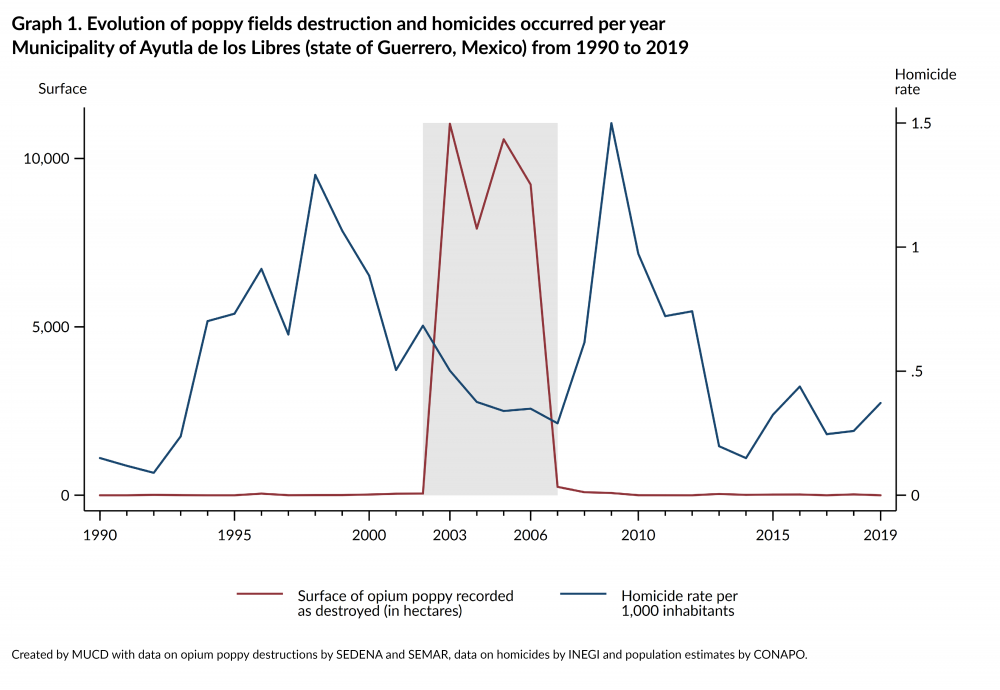
According to Gaussens, Álvarez, and Frissard,17 poppy cultivation in Ayutla is limited almost exclusively to the Sierra zone in the north of the municipality, where Tlapaneca (Me’phaa) towns interact with communities in the neighboring municipality of Acatepec, more than with their own cabecera, Ayutla, which is dozens of kilometers away, accessible only on an unpaved road. Meanwhile, the data on homicides gathered by the National Institute of Statistics and Geography (Instituto Nacional de Estadística y Geografía), which are recorded at the intra-municipal level, indicate that 44% of the homicides in Ayutla resulted from aggressions committed in the cabecera,18 murders that were probably not linked to the dynamics of poppy cultivation or the destruction of plantations.
In Ayutla, Guerrero, the army used poppy destruction as a pretext to justify its militarization of the municipality in the early years of the decade 2000, when its real objective was to conduct counterinsurgency operations.
In his ethnographic study of the marked increase in homicides between 2008 and 2012 (a period that coincided with reduced poppy destruction in Ayutla), Berber discovered that the dynamics of lethal violence observed in the municipality were concentrated in the cabecera and associated with the appearance of “violent intermediaries”, totally unrelated to the dynamics of poppy production in the sierra Me’phaa.19 Both sources –the INEGI’s database on homicides by locality, and Berber’s work– thus refute the hypothesis that the intensified eradication carried out in Ayutla, which logically meant a larger presence of public security forces, was related to the reduction of lethal violence between 2003 and 2006.
Although the official discourse of the anti-narcotics strategy is based on arguments of public security, the case of Ayutla in 2003-2006 seems to obey other logics. Work by Gaussens, Álvarez, and Frissard20 demonstrates that the Army used poppy destruction as a pretext to justify its militarization of the municipality of Ayutla in the early years of the decade 2000, when its real objective was to conduct counterinsurgency operations. Those events were triggered by the massacre perpetrated by the 27th Military Battalion in the community of El Charco,21 and the ensuing expansion of the bases of support for the People’s Insurgent Revolutionary Army (Ejército Revolucionario del Pueblo Insurgente, ERPI) in the Costa Chica region of Guerrero.
Beyond homicides. Other forms of violence to be visibilized.
Any analysis of the violences that occur in poppy-growing municipalities must set out from the fact that the Army’s destruction of poppy plantations is, in itself, a violent measure. First, it represents the economic loss of investments in labor and resources that affects only the peasant producers, never intermediaries or drug lords. Moreover, the permanent presence of the Armed Forces in these zones clearly reflects the power schemes that the Mexican State employs to deal, differentially, with distinct territories, and that contributes to “criminalizing” poverty.
The role of the authorities in poppy-producing zones is thus constructed of deep contradictions between tolerating or supporting, or regulating and repressing, illicit activities, but it always ends up creating categories of citizens that are denied all possibility of a positive integration into society.22
These schemes of domination and the continuity between counterinsurgency policies and the “war on drugs” construct contexts of almost total impunity for the actions of Mexico’s Armed Forces. The criminalization of emblematic territories of drug production and transport, and the resulting stigma placed on their inhabitants, fuel mechanisms of revictimization that transfer responsibility for violence to those who suffer it because they do not meet the subjective criteria to be considered what Christie defines as the “ideal victim”;23 understood as a weak individual who plies a respectable trade, and is attacked while performing an action free of reproach or is under the domination of an aggressor whom she/he does not know and with whom there is no kind of relation, but who has sufficient influence to vindicate her/his status as a victim in the eyes of society and the authorities. In this light, the scenarios of the destruction of illicit crops have historically offered fertile ground for serious human rights violations.
What we can affirm without fear of contradiction, is that poppy eradication has been directly linked with other forms of violence that, though more difficult to quantify, are no less tangible for the populations that fall victim to them.
The recommendations24 of Mexico’s National Human Rights Commission (Comisión Nacional de los Derechos Humanos, CNDH) expose the brutality wielded by the Armed Forces under the pretext of “combatting drug-trafficking”. For example, recommendation 29VG/201925 details the testimony of Victim #6 of events that occurred in Sinaloa:
… [on] the 11th (sic, actually the 17th) of September, 2015, around 4:20 p.m., he was home… at that moment, several Navy vehicles arrived and he heard a loud noise at the garage door because they ran a “Hummer” (vehicle) into it, knocking it down so members of the Navy could enter the domicile [where they] tortured and beat him, fracturing two ribs and the left clavicle, and applied electrical shocks to his genitals […] the Naval agents said ”he had to tell them where the drugs and weapons were”.
Serious human rights violations like this one do not involve only civilians, but also elements of the Armed Forces. The victims in recommendation 16VG/201826 were members of the military who were tortured by soldiers in Durango, another state with high levels of poppy production. The following is an excerpt from the testimony of victim 1 (V1), who at that time was a Private in the Infantry:
Upon arriving, he was put in a room… they sat him on a chair, blindfolded “his eyes” and “tied his arms and legs to immobilize him”; then he was interrogated on his relations with SP-Military 2 concerning “organized crime in the town square of Durango… [he was told] not to be stupid, just to tell them the truth to avoid a beating”… he was struck “on the head several times because he had no idea what they were asking him about”… a person in civilian dress, who said he was a “Lawyer from the SIEDO”, told him that “because I refused to cooperate… he would see to it that… I was placed at the disposition of a federal judge and sent to federal prison”… they placed a plastic bag over his head trying to asphyxiate him, while punching him in the stomach… this went on until three a.m. the next day.
Victim 2 in this case was a First Sergeant of War Materials:
He was led to a locker while being pressured psychologically to confess “that he had illicit weapons or objects”… when they didn’t find anything, a vehicle took him to the installations of the 72nd Infantry Battalion… upon arrival he was entered into a dormitory for officials where he was pressured by members of the military judicial police to admit that he “… worked for a cell of organized crime, and that if I didn’t they had two officials who would denounce me as a member of organized delinquency”.
In addition to the recommendations emitted by the CNDH, reports in the press have documented the violences practiced in growing areas that offer a more local perspective. In 2015, in the town of Acachuane in Tamazula, Durango, for example, Navy personnel in a helicopter fired into a group of children and adolescents, killing and injuring several. According to one witness:27
… the marines came on a witch hunt to see who they could take prisoner and pass off as criminals, since they’re accustomed to doing that. They always go against children or adolescents because they think they’re defenseless. We tried to get up there, but they blocked the way, there were maybe 20 Navy vehicles, helicopters were flying over the zone.
This witness went on to say:
… we don’t understand how they can be so cruel to us. A few months ago [a report] on TV said they’d grabbed some delinquents, but they were just humble townsfolk. Right away, the whole country hated those people, assuming they were delinquents, and applauded the ones who should have been hauled off to jail for lying and blaming innocent people. Because that’s what they do. Communities in the Sierra serve that purpose for the Navy, Army and Federal Police [who] come to pick up supposed delinquents and traffickers just to make themselves look good. We get screwed, and the real criminals just get on with their business.
These can hardly be considered testimonies of exceptional cases. Rather, they are a small sample of the serious human rights violations that occur in the context of Mexico’s “war on drugs”. As national and international civil society organizations have documented,28 the participation of the Armed Forces in public security tasks (including the eradication of poppy fields) generates conditions that foster the intensification of numerous forms of violence. As a result, key research questions and public policy issues center not just on whether poppy production generates violence, but on how the eradication of illicit crops induces violence in communities.
Conclusion.
What comes next?
As the case of Ayutla de los Libres in Guerrero demonstrates, we cannot simply compare data on homicides and eradication campaigns to determine levels of violence. Indeed, a rigorous evaluation of the effects of eradication on homicidal violence at the local level will require a much finer breakdown of the data, complemented by fieldwork.
What we can affirm without fear of contradiction, is that poppy eradication has been directly linked with other forms of violence that, though more difficult to quantify, are no less tangible for the populations that fall victim to them. As reports in the press and the CNDH’s recommendations have manifested for decades, the “war on drugs” has resulted in the criminalization of territories that, in the best cases, means that people lose the crops from which they expected to obtain recourses to feed their families,29 while in the worst scenarios, people disappear, are deprived of their freedom, tortured, even murdered.
It is difficult to link these realities to the myths of the grand “drug lords” and the “kingpin strategy” –that is, making lists of high-priority targets and ‘beheading’ criminal groups by arresting their “leaders”30 they do contribute to the establishment of regimens of exception, as can be seen in poppy-producing zones: territories where eradication and multiple practices of violence are exerted, in part, by the forces of public order that use the threat of the “drug lords” to impose a brutal form of social order.
Finally, another area of the expression of violence has been little studied in Mexico, though it involves two essential topics: health and the environment. What do we know today about the effects of the fumigation of poppy fields from the air on the people exposed, directly or indirectly, to the herbicides applied, or on the quality of the soil and water where the substances sprayed eventually end up? From 1990 to 2019, 13% of the total surface area of poppy cultivation that the authorities registered as destroyed was sprayed from the air. The municipalities with the greatest exposure to this method of destruction (over 4,000 h during that 30-year period) include Chilpancingo del Bravo (Guerrero), Guadalupe y Calvo (Chihuahua), Badiraguato (Sinaloa), Ayutla de los Libres (Guerrero), General Heliodoro Castillo (Guerrero), and Tamazula (Durango).
According to information from SEDENA, these operations continue in 2021 using Paraquat,31 a non-selective herbicide that is prohibited in several countries worldwide due to its potential for harming health and the environment.32 While the debate surrounding spray fumigation has become extremely intense in Colombia in recent years, in Mexico an eerie, absolute silence reins, as if the damage caused by this element of the anti-narcotics strategy does not merit attention because it affects only marginalized territories in the country. Meanwhile, the Army continues to spray Paraquat in poppy-growing areas of the sierra, indiscriminately destroying corn or bean fields that lie close to the targeted poppy plantations.33
Although it is necessary to continue documenting these phenomena and to reach a better understanding of the finer dynamics of violence in poppy-producing regions, the first step of a public pacification policy must consist in eliminating the mechanisms of violence that operate in the hands of the authorities themselves.
Notes
- See, for example: Britto, Lina, Marijuana Boom: The Rise and Fall of Colombia’s First Drug Paradise, UC Press, 2020. Gootenberg, Paul, Andean Cocaine: The Making of a Global Drug. Chapel Hill: University of North Carolina Press. 2008. ↩︎
- Peter Andreas, Joel Wallman, “Illicit Markets and Violence: What is the Relationship?”, Crime, Law, and Social Change, vol. 51, 2009, p. 225-229. ↩︎
- See the text by Cecilia Farfan-Mendez in this dossier: “Sinaloa is not Guerrero”. ↩︎
- See Fernando Escalante’s work on this topic in, El crimen como realidad y representación. Contribución para una historia del presente, Mexico, El Colegio de México, 2012. ↩︎
- Dennis Rodgers, “Slum Wars of the 21st Century: Gangs, Mano Dura and the New Urban Geography of Conflict in Central America”, Development and Change, vol. 40, no. 5, 2009, p. 949-976. ↩︎
- For an analysis of the violences lived in various communities in Mexico, see Co-Constructing Human Security in Mexico: A Methodology and Action Plan from Communities to the State. ↩︎
- A hectare is equivalent to an area appreciably larger than a football field. ↩︎
- Michoacán, Jalisco, and Sonora also figure among the states with “medium incidences” due to their high figures for the destruction of marihuana crops. See SEDENA, 2018, Memoria Documental. Erradicación de cultivos ilícitos (mariguana y amapola) (MD-09). ↩︎
- Of these municipalities, 23 are in Guerrero, 11 in Durango, 7 in Sinaloa, 5 in Chihuahua, 2 in Nayarit, and 2 in Oaxaca (see the detailed list in the annex, Table 1). ↩︎
- According to population projections by CONAPO and the INEGI’s National Population and Housing Census (Censos Nacionales de Población y Vivienda) for 2000 and 2010, the average population of these municipalities exceeded 500,000 inhabitants between 1990 and 2019. ↩︎
- Since only 6 of these 50 municipalities had an average population equal to or greater than 100,000 inhabitants between 1990 and 2019, we decided to examine homicide rates per 1,000 inhabitants to obtain a scale more in accordance with the number of inhabitants in each municipality examined. ↩︎
- We say “only” to emphasize the differences in homicide rates among municipalities. It is not to be understood as an acceptance of lethal violence or a minimization of the violence experienced by victims and their families. ↩︎
- Surfaces equivalent, respectively, to the destruction of 0.26% and 0.22% of the entire municipal area each year, on average. ↩︎
- Response from SEDENA to a solicitude for access to information, folio number 0000700203120. ↩︎
- Data gathered during fieldwork carried out in the area in autumn 2020. ↩︎
- See Pierre Gaussens, Irene Álvarez, and Paul Frissard, “En nombre de la amapola: erradicación y contrainsurgencia en Guerrero” (2021) for a discussion of the atypical character of these figures and their potential explanation through counterinsurgency operations conducted in Ayutla in the same period. ↩︎
- Pierre Gaussens, Irene Álvarez, and Paul Frissard, op. cit., 2021. ↩︎
- The INEGI began to register Information on the geostatistical locality (intramunicipal unit) of the occurrence of homicides in its databases in 2001. ↩︎
- Miguel Ángel Berber, “Intermediarios violentos: el uso y la organización de la fuerza como negocio en Ayutla de los Libres”, Estudios Sociológicos, XXXV: 104, 2017, pp. 267-291. ↩︎
- Pierre Gaussens, Irene Álvarez, and Paul Frissard, op. cit., 2021. ↩︎
- Braulio Isac Hidalgo and Costilla Gutiérrez, “El Charco. La República del Silencio. 22 años de impunidad”, Pie de página, 6 June 2020. ↩︎
- Mariana Mora, “La criminalización de la pobreza y los efectos estatales de seguridad neoliberal: reflexiones desde la Montaña, Guerrero”, Revista de Estudos & Pesquisas sobre las Américas, vol. 7, no. 2, 2013, pp. 174-208. ↩︎
- Nils Christie, “The Ideal Victim”, in: Ezzat A. Fattah (eds.) From Crime Policy to Victim Policy, 1986, pp. 17-30. ↩︎
- “The recommendations are fundamental instruments of the CNDH for the protection and defense of human rights. The recommendations constitute an urgent solicitude to the authorities to provide attention to the victim, such that she/he can return her/his situation to the state in which it existed before suffering damage, though they are not binding.” ↩︎
- CNDH 2019. ↩︎
- CNDH 2018. ↩︎
- Grieta, “Marina dispara desde helicóptero contra niños y adolescentes en poblado de Durango; hay muertos y heridos”, 16 June 2015. ↩︎
- See, for example: Human Rights Watch, “Uniform impunity. Mexico’s Misuse of Military Justice to Prosecute Abuses in Counternarcotics and Public Security Operations”, 29 April 2009. Amnesty International, “Surviving death: police and military torture of women in Mexico”, 28 June 2016. Amnesty International, “Out of control: torture and other ill-treatment in Mexico”, 4 September 2014. ↩︎
- For analyses of the huge disadvantages that growers face, see our dossier on the social and economic factors that exist in poppy cultivation. ↩︎
- See the analysis by Carlos Pérez Ricart in the journal Nexos: “La Kingpin Strategy: ¿qué es y cómo llegó a México?, October 2019. ↩︎
- Response to a solicitude for access to information, folio number 0000700094521. ↩︎
- European Union Tribunal of Justice, Press release no. 45/07, “THE COURT OF FIRST INSTANCE ANNULS THE DIRECTIVE AUTHORISING PARAQUAT AS AN ACTIVE PLANT PROTECTION SUBSTANCE”, 11 July 2007. ↩︎
- Andrea Vega, “Avionetas devastaron cultivos al fumigar en comunidades pobres en Guerrero, acusa ONG”, Animal Político, 15 February 2019; Rosalba Ramírez, “Pide alcalde de Chichihualco que el gobierno federal deje de fumigar plantíos de poppies”, El Sur, 6 November 2019. ↩︎

